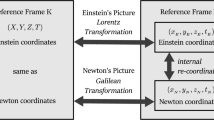Abstract
Recently Abramowicz and Bajtlik (arXiv:0905.2428 (2009)) have studied the twin paradox in Schwarzschild spacetime. Considering circular motion they showed that the twin with a non-vanishing 4-acceleration is older than his brother at the reunion and argued that, in spaces that are asymptotically Minkowskian, there exists an absolute standard of rest determining which twin is the oldest at the reunion. Here we show that with vertical motion in Schwarzschild spacetime the result is the opposite: The twin with a non-vanishing 4-acceleration is younger. We also deduce the existence of a new relativistic time effect, that there is either a time dilation or an increased rate of time associated with a clock moving in a rotating frame. This is in fact a first-order effect in the velocity of the clock, and must be taken into account if the situation presented by Abramowicz and Bajtlik is described from the rotating rest frame of one of the twins. Our analysis shows that this effect has a Machian character since the rotating state of a frame depends upon the motion of the cosmic matter due to the inertial dragging it causes. We argue that a consistent formulation and resolution of the twin paradox makes use of the general principle of relativity and requires the introduction of an extended model of the Minkowski spacetime. In the extended model Minkowski spacetime is supplied with a cosmic shell of matter with radius equal to its own Schwarzschild radius, so that there is perfect inertial dragging inside the shell.
Similar content being viewed by others
References
L. Marder, Time and the Space-Traveller (George Allen & Unwin, London, 1971)
E. Eriksen, O. Grøn, Eur. J. Phys. 11, 39 (1990)
T.A. Debs, M.G.L. Redhead, Am. J. Phys. 64, 384 (1995)
H. Nicolić, Found. Phys. Lett. 13, 595 (2000)
L. Iorio, Found. Phys. Lett. 18, 1 (2006)
Ø. Grøn, S. Hervik, Einstein’s General Theory of Relativity (Springer, New York, 2007)
H.I.M. Lichtenegger, L. Iorio, “The twin paradox and Mach’s principle”, ArXiv:0910.1929 (2009)
M.A. Abramowicz, S. Bajtlik, W. Kluzniak, Phys. Rev. A 75, 044101 (2007)
M.A. Abramowicz, S. Bajtlik, “Adding to the paradox: the accelerated twin is older”, ArXiv:0905.2428 (2009)
A. Einstein, Naturwissenschaften 6, 697 (1918)
O. Grøn, E. Eriksen, Gen. Relativ. Gravit. 21, 105 (1989)
B.H. Holstein, A.R. Swift, Am. J. Phys. 40, 746 (1972)
O.G. Grøn, Am. J. Phys. 77, 373 (2009)
S.P. Boughn, Am. J. Phys. 57, 791 (1989)
D.F. Styer, Am. J. Phys. 75, 805 (2007)
C. Giannoni, O. Grøn, Am. J. Phys. 47, 431 (1979)
E. Minguzzi, Am. J. Phys. 73, 876 (2005)
The fact that clocks moving freely in the vertical direction and along a circular path in the Schwarzschild spacetime age differently was noted several years ago by W. Rindler, Essential Relativity, 1st edition (Springer, 1969) Exercise 8.13
J.C. Hafele, R.E. Keating, Science 177, 166 (1972)
J.C. Hafele, R.E. Keating, Science 177, 168 (1972)
J.C. Hafele, Am. J. Phys. 40, 81 (1972)
R. Schlegel, Am. J. Phys. 420, 183 (1974)
N. Ashby, Living Rev. Relativity 6, 1 (2003)
Ø. Grøn, Lecture Notes on the General Theory of Relativity (Springer, 2009)
F.L. Markley, Am. J. Phys. 41, 1246 (1973)
C. Møller, The Theory of Relativity (Oxford, 1952) chapt. 8
H. Thirring, Phys. Z. 19, 33 (1918)
D.R. Brill, J.M. Cohen, Phys. Rev. 143, 1011 (1966)
J.M. Cohen, D.R. Brill, Nuovo Cimento 54, 209 (1968)
H. Pfister, H.K. Braun, Class. Quantum Grav. 2, 909 (1985)
S.M. Lewis, Gen. Relativ. Gravit. 12, 917 (1980)
C. Klein, Class. Quantum Grav. 10, 1619 (1993)
J. Barbour, H. Pfister (Editors), Mach’s Principle (Birkhauser, 1995)
H. Pfister, “Dragging Effects Near Rotating Bodies and in Cosmological Models”, in ref. BarbourPfister, pp. 315--331
C.A. Lopez, Phys. Rev. D 30, 313 (1984)
O. Grøn, Phys. Rev. D 32, 1588 (1985)
J. Frauendiener, “On the Interpretation of Dragging Effects in Rotating Mass Shells”, in ref. BarbourPfister, pp. 353--363
J. Overduin, “Spacetime and Spin”, Homepage of Gravity Probe B, http://einstein.stanford.edu/SPACETIME/spacetime4.html
C. Schmid, Phys. Rev. D 74, 044031 (2006)
C. Schmid, Phys. Rev. D 79, 064007 (2009)
A. Einstein, Ann. Phys. 49, 769 (1916)
V. Faraoni, F.I. Cooperstock, Astrophys. J. 587, 483 (2003)
H. Dingle, Science at the Crossroads (Martin Brian & O’Keeffe, London, 1972)
Author information
Authors and Affiliations
Corresponding author
Rights and permissions
About this article
Cite this article
Grøn, Ø., Braeck, S. The twin paradox in a cosmological context. Eur. Phys. J. Plus 126, 79 (2011). https://doi.org/10.1140/epjp/i2011-11079-7
Received:
Accepted:
Published:
DOI: https://doi.org/10.1140/epjp/i2011-11079-7



